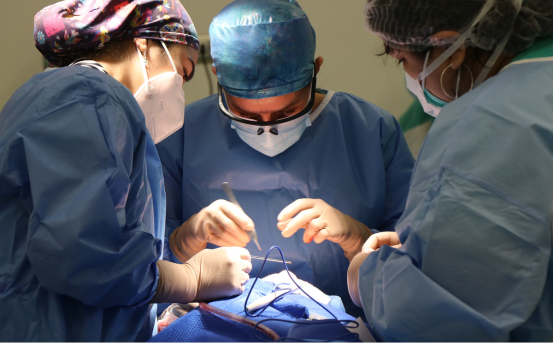Inguinal hernia repair surgery is one of the most common types of hernias and occurs when soft tissue, usually part of the intestine, protrudes through a weak spot in the lower abdominal muscles. This can cause discomfort, swelling, and pain especially during physical activity. Thankfully, hernia repair surgery is a safe and effective treatment.
Inguinal hernias are highly treatable through surgery. Inguinal hernia repair surgery is a routine and effective procedure that restores normal anatomy, reduces symptoms, and prevents recurrence. Whether you’ve just been diagnosed or are exploring your treatment options, understanding the types of inguinal hernia repair surgeries available can help you make informed decisions about your care.
What is an Inguinal Hernia?
An inguinal hernia occurs in the groin region, where part of the intestine or fat pushes through a weakened spot in the abdominal wall. It is more common in men than women and can occur due to heavy lifting, chronic coughing, obesity, or even genetic predisposition.
There are two types of inguinal hernias :-
-
Indirect Inguinal Hernia :- Often congenital and more common in children and young adults. The hernia sac enters the inguinal canal through a deep internal ring.
-
Direct Inguinal Hernia :- Develops over time due to weakening of abdominal muscles, common in older adults. It protrudes directly through a weak area in the abdominal wall.
Regardless of type, inguinal hernias typically do not heal on their own and require surgical intervention.
When is Surgery Needed for Inguinal Hernia?
Not all inguinal hernias require immediate surgery. Small hernias that cause no symptoms may be monitored. However, surgery is usually recommended if :-
-
The hernia is painful or growing
-
Daily activities are affected
-
There is a risk of complications like strangulation, where blood supply to the trapped intestine is cut off (a surgical emergency)
Types of Inguinal Hernia Repair Surgery
There are two main approaches to inguinal hernia repair surgery :-
-
Open Hernia Repair Surgery (Herniorrhaphy or Hernioplasty)
-
Laparoscopic Hernia Repair Surgery
Let’s explore each in detail.
Open Inguinal Hernia Repair Surgery
Open hernia repair is the traditional method where a single large incision is made in the groin area.
Types of Open Hernia Repairs :-
-
Herniorrhaphy :- The surgeon pushes the hernia back in place and stitches the muscle wall without using mesh.
-
Hernioplasty :- A surgical mesh is placed to strengthen the muscle wall after repositioning the hernia. Mesh reinforcement lowers the risk of recurrence.
Procedure :-
-
Local, spinal, or general anesthesia may be used.
-
The surgeon makes a 6–8 cm incision in the groin.
-
The hernia sac is identified and returned to the abdomen.
-
Mesh is placed over the weak spot and sutured.
Recovery :-
-
Recovery takes about 4 to 6 weeks.
-
Slight pain, bruising, and swelling are common.
-
Activities like heavy lifting should be avoided during recovery.
Pros :-
-
Suitable for large or recurrent hernias.
-
Can be done under local anesthesia for high-risk patients.
Cons :-
-
Longer recovery compared to laparoscopic surgery.
-
Larger scar and higher risk of infection.
Laparoscopic Inguinal Hernia Repair Surgery
Laparoscopic surgery is a minimally invasive technique that uses small incisions and a camera to guide the procedure.
Types of Laparoscopic Hernia Repairs :-
-
TAPP (Transabdominal Preperitoneal Repair) :- Instruments enter through the peritoneal cavity; the mesh is placed between the abdominal wall and peritoneum.
-
TEP (Totally Extraperitoneal Repair) :- No entry into the peritoneal cavity; mesh is placed in the preperitoneal space.
Procedure :-
-
General anesthesia is required.
-
3 small incisions are made in the abdomen.
-
A laparoscope (thin tube with camera) and surgical tools are inserted.
-
The hernia is repaired using mesh, similar to open hernioplasty.
Recovery :-
-
Faster recovery usually within 1 to 2 weeks.
-
Less pain and minimal scarring.
-
Lower risk of post-operative infections.
Pros :-
-
Quicker return to daily activities.
-
Less post-surgical discomfort.
-
Best for patients with hernias on both sides (bilateral).
Cons :-
-
Requires general anesthesia.
-
Slightly higher cost.
-
Not suitable for all patients, especially those with previous abdominal surgeries or large hernias.
Choosing the Right Type of Surgery
The choice of hernia surgery depends on several factors :-
-
Size and type of hernia
-
Patient’s age and health condition
-
Surgeon’s expertise
-
Availability of laparoscopic facilities
-
Cost and recovery expectations
Your doctor will evaluate these aspects and recommend the most appropriate method. Laparoscopic surgery is often preferred for younger patients or those with bilateral hernias, while open surgery remains a reliable option for older adults or larger hernias.
Risks and Complications
All surgeries carry some risks. Common complications after inguinal hernia repair may include :-
-
Bleeding or infection at the incision site
-
Temporary groin pain or numbness
-
Swelling or bruising
-
Hernia recurrence
-
Damage to nearby nerves or blood vessels
Laparoscopic surgery generally has fewer complications, but it is essential to follow post-operative instructions carefully to minimize risks.
Post-Surgery Care Tips
Here are some general tips for a smooth recovery after hernia surgery :-
-
Follow your surgeon’s advice about rest and movement.
-
Avoid lifting heavy objects for at least 4–6 weeks.
-
Maintain a high-fiber diet to avoid constipation.
-
Keep the surgical area clean and dry.
-
Wear loose-fitting clothes to reduce discomfort.
-
Attend follow-up appointments to ensure proper healing.
If you experience severe pain, fever, or swelling, contact your doctor immediately.
Conclusion
Inguinal hernias may seem minor at first, but they can lead to serious complications if left untreated. Fortunately, inguinal hernia repair surgery is a well-established procedure with high success rates. With options like open surgery and laparoscopic techniques, patients have access to safe and effective treatment methods tailored to their needs.























